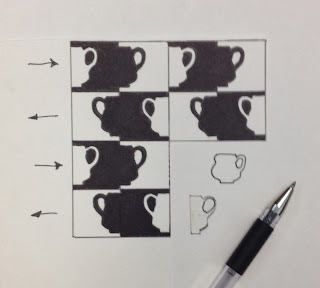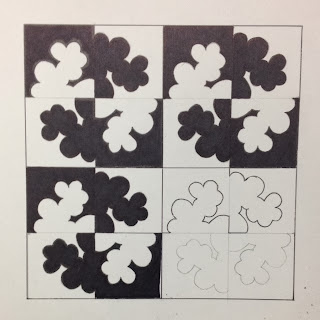PROJECT #3
POSITIVE/NEGATIVE
SPACE, PATTERN, AND TESSELLATION
Objective:
This project will utilize grids,
templates and color for the division of space and the development of regular
geometric pattern using the technique of tessellation.
Materials:
-
Bristol Board
-
Black Micron Pens
-
Pencil
-
Colored markers
- Razor knife or scissors
Procedure:
Step 1
Using the
provided grids for pattern development, experiment with several ways of
creating patterns by using the tessellation method. The removed/added shape should not take up
more than half of the original shape.
Step 2
After
deciding upon the patterns you wish to use in your project, create templates
for tracing your tessellation shapes onto Bristol board with pencil. Make
sure the outer edges of your templates are slightly smaller than the prescribed
grid size so that everything lines up when you trace them.
Step 3
Create
the following tessellation designs:
#1 Directional Square (black and white) 8"X8" format with 2"X2" squares as a grid
#2 Square Rotation (2 colors) 8"X8" format with 2"X2" squares as a grid
#3 Directional Hex (2 colors) 10"X10" format with the grid made as described
#3 Directional Hex (2 colors) 10"X10" format with the grid made as described
#4 Hex Rotation (3 colors) 10"X10" format with the grid made as described
Presentation:
-All 4 designs
should be presented in the designated size formats
-All
designs must be done first in pencil, filled in with marker of the selected
color, and then have all borders traced in a fine micron pen.
TIPS FOR SUCCESS:
-a fine sharpie pen will bleed and look bad.
-all designs colored with marker must have a black outline surrounding the tessellation component as shown on the last example of this page.
-each design in the project must represent a different tessellation component. (4 total)
-each tessellation must represent an appropriate level of complexity for college level work.
-all construction lines made in pencil must be erased.
-a fine sharpie pen will bleed and look bad.
-all designs colored with marker must have a black outline surrounding the tessellation component as shown on the last example of this page.
-each design in the project must represent a different tessellation component. (4 total)
-each tessellation must represent an appropriate level of complexity for college level work.
-all construction lines made in pencil must be erased.
-ALL
FILLING IN WITH MARKER SHOULD BE DIRECTIONAL AND ACCOUNT FOR MAKER BLEED
REPRESENTING CARE FOR CRAFTSMANSHIP
_________________________________________________________
_________________________________________________________
triangle regular
triangle side by side
square regular
square rotation
square reversed
hex regular
hex rotation
directional regular square tessellation example
rotation square tessellation example
MAKING THE HEX GRID
The grid for the Hex pattern consists of a 10"X10" square divided by 11 vertical lines spaced at 7/8" and 13 horizontal lines spaced at 1/2" and 1" every other interval. note: the last space on the right side will be 3/8" and the bottom will be 1/2"
The hex pattern will fit into the grid in this manner.
directional hex example
----------------------------------------------------------------------------------------------------
MAKING A HEXAGONAL TEMPLATE
Choose the shape to be removed from the hex.
Duplicate the exact shape and arrange the duplicates in a triangular fashion on the hex form.
Cut the shapes out with a razor knife and place them on the outer edges of the hex.
Trace the assemblage on to a scrap of bristol board and cut the template out as a single piece.
Place the template onto the drawn grid and trace it for accurate duplication of the tessellated hex.
Note: The inner and outer cutaway shapes appear smaller so the template may have to be modified for more accurate results.
the 3 color rotation design schematic
3 color rotation design example by Jake Allee
Cassidy Maes
Josh Felix
Sara Burch
Josh Felix
Sara Burch
Zach Wilson
Austin Schneider
Katie Rivera
Austin Schneider
Austin Schneider
Kyle Fowler
Zach Wilson
Cassidy Maes
Jon Cira
Josh Schneider
Kyler Fowler
Josh Dillinger




































